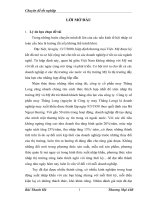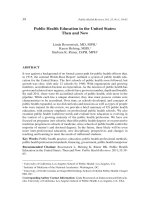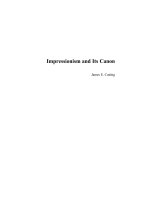long time gone sixties america then and now
Bạn đang xem bản rút gọn của tài liệu. Xem và tải ngay bản đầy đủ của tài liệu tại đây (1.17 MB, 245 trang )
long
time
gone
VIEWPOINTS ON AMERICAN CULTURE
Edited by Catherine Clinton
Viewpoints on American Culture offers timely reflections for twenty-first century
readers. A sensible guide to knowledge in a scholarly field, something one can pick
up—literally and figuratively—seems to be facing extinction. Volumes in our series
will provide intellectual relief and practical solution.
The series targets topics where debates have flourished and brings together the voices
of established and emerging writers to share their own points of view in a compact
and compelling format. Our books offer sophisticated, yet accessible, introductions
into an array of issues under our broad and expanding banner.
Sifters: Native American Women’s Lives
Edited by Theda Perdue
Long Time Gone: Sixties America Then and Now
Edited by Alexander Bloom
long
time
gone
SIXTIES AMERICA
THEN AND NOW
Edited by Alexander Bloom
1
2001
3
Oxford New York
Athens Auckland Bangkok Bogotá Buenos Aires Calcutta
Cape Town Chennai Dar es Salaam Delhi Florence Hong Kong Istanbul
Karachi Kuala Lumpur Madrid Melbourne Mexico City Mumbai
Nairobi Paris São Paulo Shanghai Singapore Taipei Tokyo Toronto Warsaw
and associated companies in
Berlin Ibadan
Copyright © 2001 by Oxford University Press, Inc. Intro © Alexander Bloom
Published by Oxford University Press, Inc.
198 Madison Avenue, New York, New York 10016
Oxford is a registered trademark of Oxford University Press.
All rights reserved. No part of this publication may be reproduced,
stored in a retrieval system, or transmitted, in any form or by any means,
electronic, mechanical, photocopying, recording, or otherwise,
without the prior permission of Oxford University Press.
Library of Congress Cataloging-in-Publication Data
Long time gone : sixties America then and now / edited by Alexander Bloom.
p. cm.—(Viewpoints on American culture)
ISBN 0-19-512514-2, ISBN 0-19-512515-0 (pbk.)
1. United States—History—1961–1969. 2. United States—Social conditions—1960–1980.
3. Nineteen sixties. I. Bloom, Alexander. II. Series.
E841 .F67 2001
973.923—dc21 00-061122
987654321
Printed in the United States of America
on acid-free paper
For
Peggy
Editing this volume has been a unique and special experience for me. I was ini-
tially approached to undertake it by Catherine Clinton, the general series editor,
and Thomas LeBien, then an editor at Oxford. Their notion was to compile a
volume around a single topic with a mixture of established and younger schol-
ars. My idea was to add public figures to the mix, along with traditional academ-
ics. Both Catherine and Thomas have been enthusiastic and thoughtful partners
in this project, offering advice and encouragement. Thomas has even continued
to provide quiet counsel since joining another press. I appreciate deeply both
their initial confidence in me and their ready assistance at every step.
My first task after agreeing to do this book was to draw up a list of poten-
tial contributors, what became a kind of “dream team” of sixties writers, schol-
ars, and activists. My assumption was that a number of them would turn me
down and younger scholars would then fill in the gaps. But with one excep-
tion, all my first choices readily agreed. It is with profound gratitude that I
acknowledge the willing and eager participation of these exceptional scholars,
respected journalists, and well-known political and social activists. The work
of the younger scholars—Karen Miller and Bradford Martin—not only keeps pace
with that of their more established cocontributors, but offers a fine balance
between those from the era and those looking back.
Along the way, a number of friends have been extraordinarily helpful in
suggesting contributors, listening to ideas, thinking of titles, and responding
to my queries. These include Patricia Sullivan, Kathryn Tomasek, Anni Baker,
Peter Warner, and, especially, Judith Smith. I want to specifically acknowledge
Christian Appy. Chris, in addition to knowing more about the Vietnam War
than anyone I know, has been an ideal coauthor and a good friend. Our work-
ing relationship has been a pleasure and model of collegiality. My research as-
sistants have helped with everything—running down the smallest facts and
sources, handling the various drafts, and helping assemble the final manuscript.
I could not have finished this without them and they have my gratitude—Jes-
sica Vickerson, Jessica Benjamin, Amy Lowe, Zachary Bloom, and, especially,
Kathryn Kyricos.
Acknowledgments
Susan Ferber inherited this project at Oxford. She has brought to it a won-
derful sense of enthusiasm as well as the finest copy pencil I have ever experi-
enced in an editor. She is able to hold the big picture and the smallest punctua-
tion mark simultaneously in her mind. She has made nearly every line in this
book better.
My sons, Stefan and Zachary Bloom, have grown up with my books. Years
ago, their main role in these books was to serve as objects of dedication. Now
they are young men with whom I can talk about ideas and share my enthusi-
asms, and they can both appreciate and contribute to my work. I am prouder
of them than anything I have ever written.
Peggy Stockman listened to my ideas, helped me think of contributors and
titles, read drafts and chapters, provided moral support when frustrations de-
veloped, and kept my perspective wide. Academics can often become insular,
looking inward and at each other, and frequently miss the real-world truths.
Peggy has always kept it, and me, real.
Brighton, Massachusetts A. B.
May 2000
viii Acknowledgments
Sixties Timeline xi
Introduction: Why Read about the 1960s at the
Turn of the Twenty-first Century? 3
The Movement We Helped to Make 11
Julian Bond
“Of This Generation”: The New Left and the
Student Movement 23
Wini Breines
Vietnam War Mythology and the Rise of
Public Cynicism 47
Christian Appy
Alexander Bloom
Running Battle: Washington’s War at Home 75
Tom Wells
Lyndon Johnson and the Roots of Contemporary
Conservatism 99
Tom Wicker
Negroes No More: The Emergence of
Black Student Activism 123
Karen K. Miller
Contents
Everything Seemed Beautiful: A Life in the
Counterculture 145
Barry Melton
Politics as Art, Art as Politics: The Freedom Singers,
the Living Theatre, and Public Performance 159
Bradford Martin
Sources of the Second Wave: The Rebirth of
Feminism 189
Sara M. Evans
Placing Gay in the Sixties 209
John D’Emilio
x Contents
1960 First lunch counter sit-ins, Greensboro, North Carolina
Woolworth’s
Student Nonviolent Coordinating Committee (SNCC)
founded
Students for a Democratic Society (SDS) founded
John Kennedy elected president
1961 Freedom rides to desegregate interstate travel
Kennedy establishes President’s Commission on the
Status of Women
1962 Port Huron Statement
Integration of the University of Mississippi by federal
marshals
Cuban Missile Crisis
1963 SDS attempts to organize the urban poor with ERAP
Project
Publication of Betty Friedan’s The Feminine Mystique
Murder of Medgar Evers, Mississippi NAACP leader
Ritual suicide of a Buddhist monk protesting the
American-backed Diem regime
Civil Rights March on Washington
Military coup overthrows Diem
Assassination of John Kennedy
1964 Beatles first American tour
Economic Opportunity Act (begins War on Poverty)
Freedom Summer
Three civil rights workers killed in Mississippi
Sixties Timeline
Civil Rights Act passed
Gulf of Tonkin Resolution
Berkeley Free Speech Movement (FSM)
Lyndon Johnson elected president
1965 Malcolm X assassinated
United States introduces American ground troops
in Vietnam
Selma March
First campus teach-ins and demonstrations against the
Vietnam War
Voting Rights Act
Watts Riots
United Farm Workers’ Cesar Chavez announces national
boycott of grapes to support striking farmworkers
Congress begins enacting Great Society legislation
1966 Martin Luther King moves campaign north to Chicago
Bill Graham begins rock shows at San Francisco’s
Fillmore Auditorium
Nationally televised Congressional hearings on Vietnam
Black Panther Party founded in Oakland, California
Founding of National Organization for Women (NOW)
Ronald Reagan elected governor of California
1967 Human Be-In, San Francisco
Muhammed Ali stripped of heavyweight championship
for refusing military induction
“Summer of Love”
Urban riots in Detroit and Newark, New Jersey
Monterey Pop Festival
March on the Pentagon
1968 Tet Offensive
Senators Eugene McCarthy and Robert Kennedy
challenge Lyndon Johnson for the Democratic
Party nomination
George Wallace runs as third-party candidate for president
My Lai massacre
xii Sixties Timeline
Lyndon Johnson suddenly withdraws from the race
Martin Luther King, Jr., assassinated
Columbia University Student Strike
French Student Strike
Robert Kennedy shot and killed
Poor Peoples’ March on Washington
Demonstrations at and boycott of Mexico City Olympics
by African-American athletes
Miss America Demonstrations
Riotous Democratic Party National Convention
in Chicago
Richard Nixon elected president
1969 Student strike at San Francisco State
Trial of the “Chicago Eight,” accused of disrupting 1968
Democratic Convention
People’s Park, Berkeley
Stonewall Riots, New York
Woodstock Festival
Weather Underground’s “Days of Rage”
Altamont rock concert
1970 First Earth Day
Creation of Environmental Protection Agency (EPA)
Nixon orders incursion into Cambodia
National guardsmen shoot and kill student demonstrators
at Kent State
Police open fire and kill students at Jackson State
University in Mississippi
First Gay Pride March
Women’s Equality Day demonstrations celebrating fiftieth
anniversary of suffrage
Jimi Hendrix dies
Janis Joplin dies
The Beatles break up
1971 William Calley convicted for My Lai murders
Pentagon Papers published
Jim Morrison dies
Sixties Timeline xiii
1972 Nixon announces mining of North Vietnamese harbors
Ms. magazine founded
Antiwar presidential campaign of George McGovern
Richard Nixon re-elected
“Christmas bombing” of North Vietnam
1973 Roe v. Wade decision legalizing abortion
Paris Peace Accords
American Indian occupation of Wounded Knee
Watergate scandal
1974 Richard Nixon resigns
1975 American withdrawal from Vietnam and the defeat of
South Vietnamese government
xiv Sixties Timeline
long
time
gone
The 1960s remain alive for Americans thirty years after the decade ended. When
the United States fought the Gulf War in 1991, the aim was not only to drive the
Iraqis out of Kuwait, but, as was explicitly stated by President George Bush, to
finally expiate the “Vietnam syndrome” from our culture. When the reaction
to the verdict in the Rodney King case sparked urban upheaval in Los Angeles
in 1992, the Bush administration blamed the riots on the “failed politics of the
’60s.” During the 1992 presidential campaign, Bill Clinton’s draft record emerged
and reemerged throughout the campaign, as well as whether or not he inhaled
marijuana.
Once elected, Bill Clinton, and first lady Hillary Clinton, became targets of
their political opponents not merely because of their politics or even their fi-
nancial dealings or personal behavior but, as Newt Gingrich put it, because they
were “counterculture McGoverniks.” In fact, the so-called Republican Revolu-
tion of 1994 was often phrased as a reaction against the 1960s. “Sixties values,”
Gingrich declared, “cripple human beings, weaken cities, make it difficult for
us to, in fact, survive as a country.” They are “to blame for most of the current
major diseases which have struck this society.” During Clinton’s impeachment
struggle, Christian Coalition head Pat Robertson lamented that the office once
occupied “by Washington and Jefferson and Lincoln” had become “the play-
pen for the sexual freedom of the poster child of the 1960s.”
Casting the contemporary world in a 1960s framework is not only the prov-
ince of politicians. In a recent academic forum titled “The Columbine Incident
and the Radical Tradition in America,” one participant argued that “kids kill-
ing kids may be the radical protest of our age.” The young killers “may be the
Mark Rudd and Abbie Hoffman [two radical leaders in the 1960s] figures of
today. . . . heirs of the youth rebellion of the ’60s. . . . They may have upped the
Introduction
Why Read about the 1960s at the
Turn of the Twenty-first Century?
4 Long Time Gone
ante on their radical forebears. . . . These boys have truly embraced ‘revolution
for the hell of it,’ maybe better than Abbie ever did.”
At the same time, the Rolling Stones continue to pack stadiums across the
country and, even more significantly, young people journeyed across the coun-
try in mock 1960s garb to follow the Grateful Dead. These fans imitated their
idea of a ’60s lifestyle, and hoped to recapture some lost sense of community and
idealism epitomized by the band and its following. The public reaction to the
death of Jerry Garcia in 1995 and the void in the culture left by the band’s decision
to call it quits suggest a very different kind of grip this past era has on our own.
The 1960s seem to hold on to us—or, at least, our mythologized vision of
the era. The decade maintains a unique place in contemporary life, unlike that
of any previous era. Decades or periods usually take on a cohesive popular
meaning once they have passed into history. A consensus about the shape and
identity of the decade settles into popular imagination. The public conjures
images of the roaring 1920s, the hard times of the 1930s, the happy days of the
1950s. These impressions are selective, overgeneralized, and frequently unaware
or dismissive of individuals or situations that defy the generalizations. Schol-
ars set about pointing out these omissions and attempt to set the record straight.
What is unique about the 1960s is that we are living with a number of
competing (and, sometimes, contradictory) popular meanings—not one con-
sensus but several. We have a divided—perhaps schizophrenic—legacy from this
era. Like the other generalized views of past eras, each of these contains errors
and simplifications. But what is most striking is the way these visions of the
1960s can contradict one another and still coexist in the popular imagination.
The 1960s remain alive in the culture in a manner different from any pre-
vious decade. We are still debating issues that emerged during that decade, still
living in the conscious aftermath of its events and transformations. It is a de-
cade that seems to hold our imaginations long after its time has passed.
We tend to think of historical periods as a single entity, as though the “sixties”
exploded full blown on the American scene, with all its elements fully realized.
In fact, it is hard even to date the era. Some have suggested that the sixties
began with the first lunch counter sit-ins at the Greensboro, North Carolina,
Woolworth’s in early 1960. Others mark the era’s birth with the organization
of Students for a Democratic Society at Port Huron, Michigan, in 1962; or with
the assassination of John Kennedy in 1963; or with the first major student dem-
onstration, the Berkeley free speech movement, in 1964.
There is no clear moment when the “sixties” began. In fact, what this list-
ing of events suggests is the emergence of a new political sensibility in the first
Introduction 5
years of the decade. Over these years and across the country, groups began to
challenge basic assumptions and institutions, from segregation to campus re-
strictions to presumptions about personal development and national goals.
Individuals drew inspiration from other events and actions—the tactics, vocabu-
lary, and idealism from one situation feeding the next.
One common denominator of the first moments of this new activism was
the participation of young people, epitomized by the names of their organiza-
tions—the Student Nonviolent Coordinating Committee (SNCC) or Students for
a Democratic Society (SDS). Young people played central roles in the impor-
tant events of the early 1960s. They sat in at lunch counters and in department
stores throughout the segregated South in 1960, rode as Freedom Riders to de-
segregate interstate travel in 1961, mounted the SDS attempt to organize the
urban poor in 1963, challenged restrictive rules and impersonal educations with
the free speech movement in 1964, and organized the first campus teach-ins
and demonstrations against the Vietnam War in 1965.
By mid-decade it was evident to all Americans that something powerful was
shaking the fundamental structures of American life. This only intensified as
the decade progressed. The southern civil rights movement gave way to a na-
tional struggle for black power, cultural identity, and race consciousness. The
Black Panther Party was founded in Oakland, California, in 1966, to protect
urban citizens from police brutality, articulating its messages in a new, more
militant tone. Martin Luther King, Jr., struggled for integration in the South,
then took his message to the North with a campaign against housing discrimi-
nation in Chicago in 1966, as well as publicly criticizing the Vietnam War in
1967. He planned to organize all those living in poverty with the Poor People’s
March on Washington in 1968. King’s assassination in April of that year not
only sparked riots throughout the country, but is often seen as one of the events
that dissipated the idealism that marked much of the decade.
King’s opposition to the Vietnam War suggests the interrelation of the move-
ments. In the first years of the 1960s, Vietnam remained an issue off center stage,
gaining attention only with a headline-grabbing event, such as the 1963 ritual
suicide of a Buddhist monk who was protesting the U.S backed Diem regime, or
the military coup that overthrew Diem later that year. In 1965, however, when
SDS called for a march on Washington to protest the war, organizers were amazed
when twenty-five thousand turned out. From that point on, regular protests
occurred throughout the country, the number of demonstrators escalating along
with the number of soldiers in Southeast Asia. In 1968, five hundred thousand
people turned out in the nation’s capital for an anti-Vietnam War protest, with
millions of others gathered in locales across the country.
6 Long Time Gone
Vietnam moved to center stage, with nationally televised congressional
hearings, antidraft protests, draft-card burnings, public counseling about draft
resistance for young men, opposition on campuses to the presence of military
recruiters, and, finally, a direct antiwar challenge in 1968 within the Democratic
Party to President Johnson’s desire for renomination. First, Minnesota Senator
Eugene McCarthy and, then, New York Senator Robert Kennedy announced their
intention to seek the nomination on antiwar platforms. Two days before the
Wisconsin primary, when it appeared LBJ was going down in defeat to McCarthy,
the president suddenly withdrew from the race. Later that primary season, after
winning in California, Robert Kennedy was shot and killed as he walked from
the ballroom where he had just given his victory speech.
The war had brought down a president and set in motion the forces that
would come together at the calamitous Democratic Convention in Chicago later
that summer. There, before national television cameras, Chicago police tear-
gassed and beat antiwar demonstrators in what an investigatory commission
later termed a “police riot.” Inside the convention hall, as the delegates smelled
tear gas and heard the chanting of demonstrators, speakers from the platform
berated the administration and the convention host, Chicago Mayor Richard
Daley, accusing him of employing “Gestapo tactics.”
The new president, Richard Nixon, seemed to promise an end to the war
in his winning campaign, but instead shifted tactics, slowly withdrawing Ameri-
can troops but massively increasing American air strikes. Demonstrations against
the war continued, and after Nixon ordered an incursion into Cambodia in the
spring of 1970, protests erupted across the nation. One confrontation, between
students and national guardsmen at Kent State University in Ohio, turned
horribly tragic, as the guard opened fire on the demonstrators, killing four and
wounding nine. Ten days later, state police opened fire on students at Jackson
State University in Mississippi, killing two more. Like the King and Kennedy
assassinations, these shootings further shattered people’s idealism, leaving them
frustrated, disillusioned, and hostile.
Yet amid the tumult and confrontation, other elements that define the 1960s
emerged, focusing on personal introspection, human interaction, and individual
improvement in the quality of life. Challenges to “the system” not only focused
on the war, the economy, or racial discrimination. The system was also seen as
offering people less meaningful lives, binding men and women to prescribed
and unfulfilling roles, and limiting human potential. Interconnected with cri-
tiques of foreign or domestic policy were visions offering new ways of construct-
ing lives. Personal and sexual exploration, redefined social arrangements, and
Introduction 7
artistic endeavors that strived to provide deeper understandings all emerged
from the same wellsprings as the political movements.
Perhaps only a small minority could actually journey to San Francisco in
the “summer of love” of 1967, but the meaning and example of alternative
lifestyles permeated society. From clothing styles to sexual freedom, the ideas
of the counterculture filtered through the nation. Life magazine might have
focused on San Francisco and Haight-Ashbury as the capital of “hippiedom,”
but these were only its most prominent outcropping. The impact was felt on
college campuses, at high schools, in big cities, in small towns, at the movies,
and on records—especially on records. Music seemed central to the entire ’60s
experience, not the narrowly defined cultural role it plays today. Rock bands
and folk singers participated in civil rights marches and antiwar rallies. But that
is only the surface relationship. The music embodied the same underlying
themes, the same sense of creating something new and something better, as
did the political and social movements. These all seemed part of the same large
endeavor.
Each new challenge inspired others. The vocabulary of civil rights—about
equal access, breaking down barriers, ending discrimination—was easily trans-
ferred to others who lived under unfair constraints. Many racial and ethnic
groups began to explore their own histories, cultures, and backgrounds. Women
made the logical jump from racial prejudice to discrimination based on sexist
views. And by decade’s end, gays and lesbians began to exert their own resis-
tance to the prejudicial treatment they had long suffered. Many of these en-
deavors, especially for women and gays, only began in the 1960s; the major
efforts and achievements came in later eras.
It is as difficult to mark the end of the 1960s as it is the beginning. The
deaths at Kent State in 1970 are often cited as one ending point. Others see the
failed antiwar presidential campaign of George McGovern in 1972 or the Water-
gate scandals of 1973 and 1974 as the end. Still others cite the American with-
drawal from Vietnam and the defeat of South Vietnam in 1975 as bringing down
the final curtain on the era. As with dating the beginning of the “sixties,”
locating its conclusion is speculative and ultimately unnecessary. Americans
know the era has ended and yet feel as though we are living in its aftermath,
still debating its issues, and still trying to decide whether it had a positive or
negative impact on contemporary American life.
It is the intention of this collection to look back at the 1960s and to under-
stand the issues of the day on their own terms, as well as to think about their
8 Long Time Gone
meanings for today. The aim is to dispel the myths and to try to construct
both an accurate vision of the past and an understanding of its contempo-
rary influences.
Lost in the modern imagery of “sixties” life is the interconnection of the
political, the cultural, and the social. Individuals’ lives, ideas, and actions wound
together—the personal became political, and the cultural and political seemed
to be two parts of a whole. A second intention of this collection is to reestab-
lish this sense of the “sixties” experience. Thus, a number of the essayists have
introduced personal stories—either their own or those of their subjects—to try
to recapture the inner resonance of life in the 1960s, that intimate intercon-
nection among elements that seem so disparate today.
Some of the contributors—Julian Bond, Barry Melton, Tom Wicker, Sara
Evans, Wini Breines, John D’Emilio, and I—were active participants in the worlds
we describe. Others came of age after the decade had passed, but understand
the relationship between their subjects’ lives and the political or cultural ac-
tivities in which they were engaged—that at any one moment, a political or
social event might move to the fore, but at every moment all the elements re-
mained in play, each influencing the other.
Each essay was written specifically for this volume. They move through the
decade, from the first civil rights sit-ins of 1960 to the emergence of a gay rights
movement at the end of the decade. Each is built around a single topic from
the period yet the impact of each can only be understood fully when explored
in relation to the others. Barry Melton’s notion that his rock group, “Country
Joe and the Fish,” became a “house band for the antiwar movement” captures
this intimate interconnection between the spheres.
Topics from one essay pop up in others. Julian Bond sketches the rise of
SNCC in his essay on the civil rights movement. Bradford Martin uses SNCC’s
Freedom Singers as an example of the merging worlds of art and politics in his
essay on the counterculture. The developments late in the decade within the
New Left, in Wini Breines’s essay, point directly to the topics discussed in Karen
Miller’s essay on black student activism, in Sara Evans’s on the women’s move-
ment, and in John D’Emilo’s on the emergence of gay rights. There are also
obvious connections between the essays on Vietnam, on Lyndon Johnson, and
on the antiwar movement.
Some of the essays offer sweeping overviews, while others choose a mo-
ment or smaller example to epitomize their topic. Always, the intent is to de-
scribe the central issues and attitudes at the time. The second intent is to as-
sess, sometimes implicitly but often explicitly, the meaning of these years and
these issues for our contemporary world. We still live with the 1960s insofar as
Introduction 9
it holds our imaginations and continues to shape the rhetoric of our political
dialog. Debates about policy or social concerns represent a playing out of po-
litical and social momentum generated in that period. We need to understand
what those forces actually were and what they mean today.
The 1960s are both the province of history and a powerful memory shap-
ing contemporary discussion. Both our history and our political dialog should
always be as accurate as possible. These essays are intended to provide some of
that accuracy—to help set the historical record and the modern discourse
straight.









